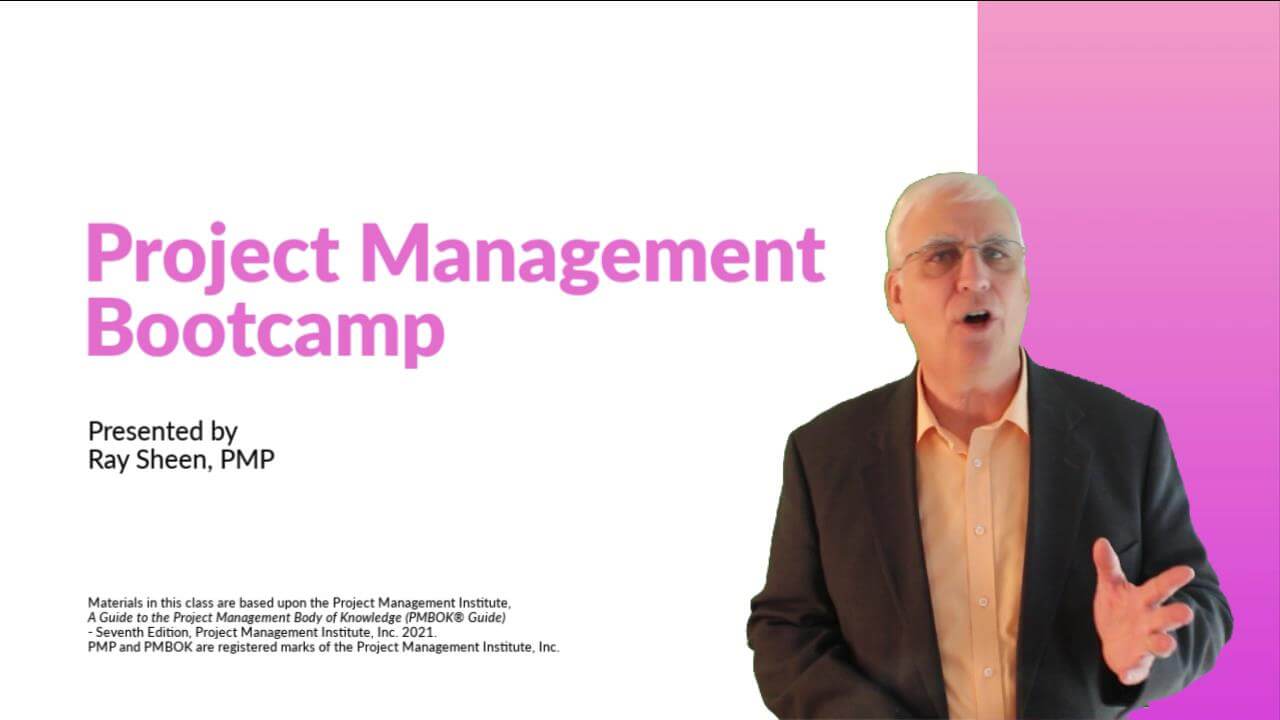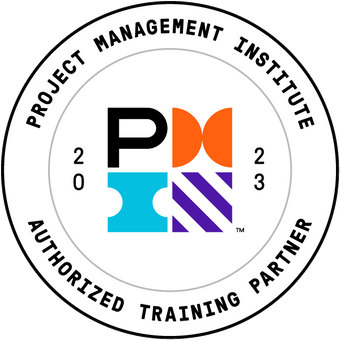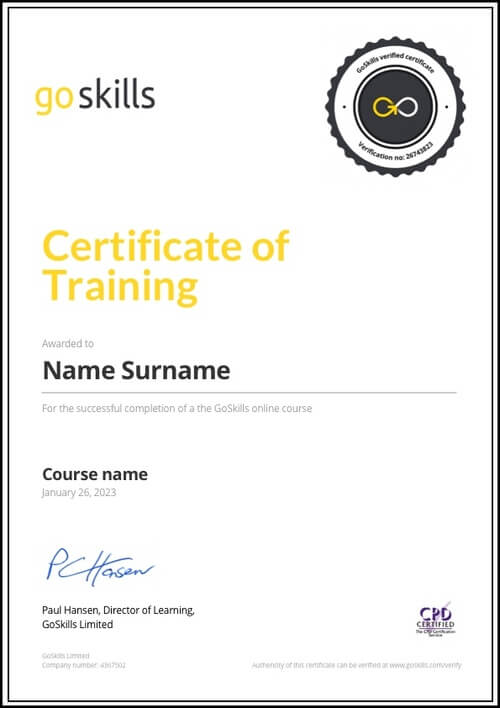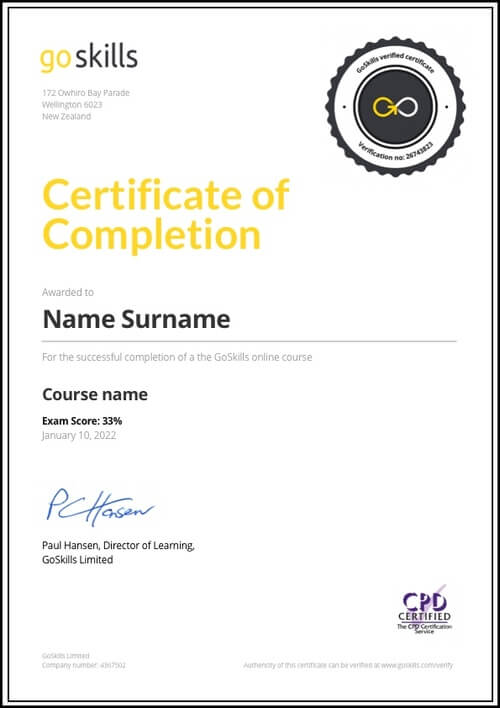Features
Premium video tutorials
Award-winning instructors
Personalized learning
Get certified
Learn at your own pace
Mobile (learn on-the-go)
Unlimited tests and quizzes
Regularly updated content
Overview
PMP certification unlocks massive opportunities for career advancement. Not only is it the top globally recognized credential for project managers, but research also shows that it can boost your salary by up to 20%.
Whether you're working towards your PMP® certification, collecting Professional Development Units (PDUs), or simply looking to improve your project management skills, this PMP certification training bootcamp will help you get there.
In a series of four foundational courses, you'll learn today's most relevant topics in project management, based on the latest Project Management Institute guidelines.
The four courses in this PMP certification training bootcamp include:
- Project Management Framework: Build a foundation to standardize your processes and account for factors that could impact your project's execution and delivery.
- Project Management Teams and Stakeholders: Master the art of good project communication so you can eliminate ambiguity and make decisions with confidence.
- Project Management Planning: Discover the key project planning steps, starting with the baseline and planning through the scope, schedule, and resource phases.
- Project Performance and Delivery: Gain the skills needed to successfully support a project through every phase to deliver desired outcomes on target and on time.
By the end of this PMP certification training, you’ll be able to:
- Demonstrate competence in running successful projects within a specified organizational context.
- Manage risk, innovation, and operations through traditional and Agile Scrum techniques.
- Transform complex ideas into an organized and optimized plan using industry best practices.
- Manage multi-disciplinary teams with seamless communication.
- Earn 60.5 PDUs or contact hours toward your Project Management education for certification with PMI.
This course is based on The Project Management Institute, A Guide to the Project Management Body of Knowledge (PMBOK® Guide) - Seventh Edition, Project Management Institute, Inc., 2021.
Once enrolled, our friendly support team and tutors are here to help with course-related inquiries.

- 720p
- 540p
- 360p
- 0.50x
- 0.75x
- 1.00x
- 1.25x
- 1.50x
- 1.75x
- 2.00x
FAQ
Who should take this PMP® course online?
- People who want to prepare for the PMP® exam.
- Project managers who want to take the next step in their careers by getting certified with PMI.
- People who want to earn the required 35 contact hours for PMI through on-demand online training.
- Busy professionals who want the flexibility to upskill at their own pace.
- Existing PMI certification holders who want to earn PDUs to maintain their certification.
- People who want the assurance of learning from an Authorized Training Partner (A.T.P.) with PMI.
For more information on how to get your PMP® certification online, including eligibility criteria, certification cost, and process, check out our handy step by step PMP® certification guide.
What does PMP® stand for?
PMP stands for ‘Project Management Professional’. It is an internationally recognized designation by the Project Management Institute (PMI).
What is a PMP® certification?
The PMP® certification is earned once you have passed the PMP® exam. It represents the utmost knowledge and experience in project management.
Earning the PMP certification enhances your credibility as a Project Manager, unlocks more job opportunities, increases your earning potential, gives you access to global networking opportunities, and more.
How to get a PMP® certification?
Here are the steps you need to take in order to earn a PMP® certification:
- Meet PMI’s prerequisites for PMP® certification of:
- Secondary degree (high school diploma, associate’s degree or global equivalent) or four year degree.
- Either 4,500 hours or 7,500 hours of experience leading projects, depending on your education level.
- 35 hours of project management education. The GoSkills PMP® course meets this requirement, and GoSkills is an Authorized Training Partner (A.T.P.) with PMI.
- Complete the online application form.
- Wait for confirmation from PMI that they have received your application.
- Pay for the exam.
- If you’re a PMI member, the PMP® exam will cost you $405. If you’re not a PMI member, then you’re looking at $555 to take the exam.
- Make an appointment to take the PMP® exam.
- Maintain your PMP® certification.
- To renew your PMP® certification, you need to earn 60 PDUs over the span of three years, report your PDUs to PMI, and pay the renewal fee of $60. GoSkills project management, finance, and lean six sigma courses are a great way to earn PDUs while learning practical skills.
You can learn more about the steps to gain your PMP® certification in detail here.
How many PDUs for PMP® certification?
If you do not hold a PMP® certification yet, you earn contact hours (also known as education hours) when you take project management training. Once you are officially certified, you earn Professional Development Units (PDUs) instead when you undertake training.
In order to take the PMP® exam, you will need a minimum of 35 contact hours. The GoSkills PMP® Certification Training course meets this requirement, awarding learners 60.5 contact hours upon completion.
Once you have earned your certification, you will need to earn 60 PDUs over the span of the next three years to maintain your certification. The GoSkills PMP® Certification Training course provides 60.5 PDUs, and you can also earn PDUs from our range of project management, lean six sigma and finance courses.
How hard is the PMP® exam?
The PMP® exam is designed to test the knowledge of experienced project managers, and as such it is one of the more difficult project management certification exams.
However, it is possible to pass the exam if you thoroughly study the PMBOK Guide, specifically the five process groups and ten knowledge areas covered in the exam. A key to scoring well in the exam is answering questions with the PMBOK Guide way of doing things, not the way you may have learned to do things in practice at your job.
Taking a course like GoSkills’ PMP® Certification Training and giving yourself enough time to adequately prepare for the exam will help give you the tools you need to be confident you have the knowledge to succeed.
How long is the PMP® exam?
The PMP® exam is 230 minutes or just under 4 hours long. There are no scheduled breaks, which means the clock will keep running should you choose to take one.
How many questions in the PMP® exam?
There are 180 questions to answer on the PMP® exam. With the time you’re allotted this roughly works out to a minute and a half per question. You will be graded on 175 of the questions only. PMI includes 25 experimental questions in each exam to gauge their value for future exams.
Do you have other project management online courses?
We have a range of project management courses to suit your needs:
- CAPM® Foundations
- CAPM® Certification Training
- Microsoft Project Fundamentals
- Project Management Basics
- Project Management Framework
- Project Management Teams and Stakeholders
- Project Management Planning
- Project Performance and Delivery
- Project Management for Engineers
- Scrum for Team Members
- Scrum for Managers
- Scrum for Scrum Masters
- Scrum for Product Owners
- Scrum for Agile Scrum Practitioners
Once enrolled, our friendly support team and tutors are here to help with any course related inquiries.
Can I train my team with GoSkills?
Absolutely. We work with many businesses, big and small, to train and upskill their staff. Get started here or contact us with your requirements.
Summary
Instructor
Syllabus
Project Management Foundation Free Lesson
1
Circles of Project Management
Circles of project management are a framework for considering different project management aspects. Based upon project and organizational considerations, some aspects may be emphasized and others de-emphasized.
2
Methods and Models
Project managers use models and methods to organize the management approach and execute the project management activities.
3
Project Tailoring
Project tailoring is the modification of a standard project management methodology to reduce risk by accommodating the unique business and project characteristics of the project.
4
Progressive Elaboration
Progressive elaboration is the principle of steadily adding detail to the project plan as more information becomes available.
5
Projects, Programs, Portfolios
Portfolios are often comprised of programs that are often comprised of projects; all of which either create or support operations.
Project Management Methodology Free Lesson
1
Project Management Methodology
2
Methodology Comparisons
The three approaches presented are three very different ways of managing a project. Understanding the differences will enable a business to select the best approach for their projects.
3
Sprint-Scrum Process
The Agile/Scrum methodology is a structured project management methodology. It follows a prescribed process that includes Sprints and Scrums.
4
Project Phases
Projects are often organized into phases. Phases provide structure and logic to the project and aid the project team and management to track progress.
5
Project Management Domains
Understanding the domains found in the PMBOK® Guide will prepare an individual to manage a project. These domains are universally applicable across industries and project types and are essential aspects of project management throughout the project lifecycle.
Uncertainty and Risk
1
Positive and Negative Risk
Understand the difference between positive and negative risk. Learn the major steps of project risk management.
2
Risk Register
The Risk Register is a table that tracks the project risk management activities.
3
Risk Identification
Risk Identification is the practice of identifying positive and negative conditions that may occur within the project and impact project objectives.
4
Risk Matrix
All project risks are not equal in their effect on a project. Project risks that have been identified are prioritized using qualitative techniques such as the Risk Matrix.
5
Negative Risk Response
Negative Risk Response is determining what actions the project will take to address risk threats.
6
Positive Risk Response
Positive Risk Response is determining what actions the project will take to address risk opportunities.
7
Contingency and Triggers
Contingencies are potential risk response actions that will only be implemented if some triggering event or condition has shown that the risk probability has gone from unlikely to likely.
Business Value
1
Project Benefits
2
Creating a Business Case
The business case provides the business rationale, normally in financial terms, of whether the project should be done.
3
Project Charter
The Project Charter is the document that approves the initiation of the project and identifies goals, objectives, boundaries, and constraints.
4
Requirements Planning
Project requirements are often vague, incomplete, or contradictory at the time of project initiation. Normally, additional effort is required to collect and verify the true project requirements.
5
In-Frame/Out-of-Frame
In-Frame/Out-of-Frame is a technique for clarifying project boundaries by listing both the activities and deliverables that are in scope for the project and listing the activities that are not required as part of the project.
6
Primary Constraint
The approach taken when planning a project should be based upon the primary project constraint. Attributes of that constraint are planned first and then other aspects of the project are planned to support the primary constraint.
7
Project Selection and Approval
The organization needs to establish a management discipline for selecting and approving projects.
Project Governance
1
Project Governance
2
Compliance Categories
3
Governance Impact
4
PMBOK® Guide
The PMBOK® Guide is the reference document upon which much of the PMP® exam is based. The PMBOK® Guide contains a description of project management domains, models, methods, tools, checklists, and templates.
5
Project Management Standard
A portion of the PMBOK® Guide is a standard for project management. That portion is Part 1, The Standard for Project Management of a Project.
6
PMIS and Project Management Software
The Project Management Information System (PMIS) is the method that the project manager and core team use to share and disseminate project information. It often is based upon the use of a project management software application.
Stakeholder Management
1
Stakeholders
The Project Stakeholders' support is essential for project success. Project Stakeholders set the goals for the project and will ultimately determine whether the project is considered a success or failure.
2
Stakeholder Identification
Identifying stakeholders enables the project team to create a strategy for each that guides the communication and interaction with each stakeholder.
3
Stakeholder's Project Goals
Many stakeholders have additional goals for a project beyond the primary business goal. Understanding those goals can help the team ensure project success and maintain stakeholder support.
4
Stakeholder Influence
Project Teams and Team Leaders
1
Project Leader
The Project Leader is responsible for ensuring the project team executes the project.
2
Core Team
Most large projects are managed by a cross-functional core team. Core team members have a dual responsibility; they are responsible for the project achieving its goals and they are responsible to ensure that the project complies with their function’s standards and best practices.
3
Project Team Leader
Team Leaders adapt to the business and team environment to ensure the team creates the performance or implements the change for which it was chartered.
4
Scrum Master/Product Owner
Agile Scrum projects rely on the leadership of the Scrum Master and Product Owner to assist the project team in accomplishing the project tasks. While neither of these individuals will be the project leader in a classic sense, both take on some of the typical responsibilities of project leadership that are necessary for effective project management.
5
Agile Culture
The Agile culture is a set of characteristics found in all the Agile methodologies. These characteristics are empowerment, adaptation, and a focus on performance.
6
Team Building
Project Team Building is a process that the Project Core Team normally goes through to improve team coordination and decision making.
7
Virtual Teams
It is common in today’s business environment to be a member of or lead a virtual project team. There are several unique challenges with these teams that the project leader must be prepared to address.
8
Changing Team Members
When project team members are changed, the project leader needs to manage both the process of saying “Goodbye” to one individual and saying “Hello” to another.
9
Training Plan
10
Measuring Training Outcomes
In the typical project of today, a project training plan is essential to address the challenges with project resources. At this time in the project, the impact of the training plan that was developed is assessed. In addition, changes to the project team will likely require modifications to the training approach.
Team Leadership
1
Setting Team Goals
Teams perform better when they have clear shared goals. One key element of good team leadership is helping your team establish team goals. This module will provide several suggested approaches for establishing goals and a set of criteria for good team goals.
2
Decision Making
Project Decision Making is the process whereby the project leader and project team decide upon project strategy, tactics, and acceptable actions.
3
Team Negotiation
Team members will often need to negotiate with each other on tasks and activities and the team leader may need to negotiate with the other managers or supervisors of team members.
4
Conflict Resolution
From time to time teams will experience conflict. When the team leader or team members are able to resolve the conflict in a positive manner, the team becomes stronger and performs better.
5
Diversity and Inclusion
6
Mentoring Teams and Stakeholders
Projects are unique and project team members are frequently changing. Project mentoring - which focuses on coaching and aligning project team members and stakeholders - is frequently required. In this case, it is less about long-term career mentoring and more about effective engagement with other project team members to ensure project objectives are met.
7
Emotional Intelligence Principles
Emotional Intelligence is a framework for improving communication and team dynamics. These principles can be used by a project manager to understand how to harness their own emotions and the emotions of others to achieve project goals.
8
Applying Emotional Intelligence
A project manager can use the principles of emotional intelligence to improve their active listening skills. In addition, the application of emotional intelligence to project team and stakeholder interactions can reduce conflict and improve alignment between individuals.
9
Situational Leadership
Project managers and core team leaders can use the framework of situational leadership to guide their interactions with team members. By assessing the readiness of team members, the project manager or core team leader can interact with a leadership style likely to improve team performance.
Communication
1
Communication Management
Project Communication Management is a very broad term that refers to all of the communication activities associated with the project. Communication is a key attribute of project management.
2
Communication Constraints
Teams rely on effective communication, yet there are many factors that can inhibit communication. When these factors are present, the team leader needs to proactively manage the team communication processes to overcome them.
3
Team Meetings
Team Meetings are a gathering of team members to discuss aspects of the project. Team pulse meetings focus on status. Team problem-solving meetings focus on problem resolution.
4
Scrum Meetings
During a Sprint, the Scrum Team meets daily at a Scrum Meeting to provide status on progress.
5
Management Meetings
Project Management Reviews are the formal documented meetings held periodically between senior management and the project team.
6
Technical Reviews
Project technical reviews are formal decision meetings between team members and a panel of subject matter experts.
7
Sprint Demonstration Planning
Sprint Demonstration Planning ensures that the Sprint Demo meeting appropriately reflects the work accomplished by the Scrum Team.
8
Overcoming Misunderstandings
Creating a Project Plan
1
Baseline Plan
The integrated project plan that includes scope, schedule, and resource information for all aspects of the project is the project baseline plan.
2
Requirements Management
Project requirements are often vague, incomplete or contradictory at the time of project initiation. Normally, additional effort is required to collect and verify the true project requirements.
3
Project Deliverables
Learn how to identify project tasks and activities using the deliverables deployment technique.
4
Project Boundaries
Learn how to quickly identify project boundaries using the W questions.
5
Approval and Kickoff
6
Work Breakdown Structure
The Work Breakdown Structure (WBS) is the most commonly used technique for organizing the project scope. The WBS decomposes the scope into tasks and organizes the tasks into logical groupings.
Scope Planning
1
WBS Dictionary
The WBS Dictionary is a table or spreadsheet that is organized by project task and contains all project planning details.
2
Task Description
Task Descriptions are the statements of scope for each of the project activities. They are written in the format of “action – completion point.”
3
Story Cards
Story Cards - also known as Product Backlog Items (PBIs) - are the technique used for documenting project scope, quality requirements, estimates, and priority of the deliverables in an Agile/Scrum project.
4
Writing Story Cards
There is an art to creating effective story cards. In this lesson, an Agile project team member will learn the best practices for writing story cards.
5
Backlog
Schedule Planning
1
Milestone Schedule
Understand when and how to use a milestone schedule on a project. Learn how to create a milestone schedule.
2
Gantt Chart
Understand when and how to use a Gantt chart on a project. Learn how to create a Gantt chart.
3
Network Diagram
A network diagram is a project scheduling technique that shows the relationship between tasks by depicting project activities as a flowchart.
4
Task List Schedule
A Task List Schedule is a schedule format used to communicate tasks with dates to extended team members or those who do not have a major role in the project.
5
Kanban Schedule
A Kanban Schedule is a project scheduling tool for managing a batch of similar items that must be processed through the same project steps.
6
Float, Slack, Buffer
Float (slack or buffer) is extra time that a task could consume beyond its duration estimate without impacting other aspects of the project. Total float is extra time without impacting the end date of the project and free float is extra time without impacting another project task.
7
Critical Path
Critical Path is a project scheduling technique that determines the shortest time that the current project plan can be completed.
8
Sprint Controls
Resource Planning
1
Resource List
The project Resource List is a list of all individuals working on the project with their contact information and all special equipment and facilities required to accomplish project tasks.
2
Responsibility Matrix
The Responsibility Matrix is a project management tool for correlating project work assignments with project team members.
3
Using Contractors and Vendors
Contractors, vendors, and suppliers are used on projects to reduce risks. These external resources have capacity and capability that allows them to complete project tasks better than internal resources would be able to complete them.
4
Project Budget
Understand what is normally shown in a project budget. Learn how to create a time-phased project budget.
5
Resource Over-allocation
Project resource demands are often inconsistent throughout the life of the project leading to times when resources are over-allocated.
Estimating
1
Estimating Techniques
The most commonly used techniques for creating project estimates are analogous estimates, bottom-up estimates, three-point estimates, and using a parametric model.
2
Time Box
Time Boxes are an estimating technique that sets a finite time for a task or task group. The amount of scope that is completed is variable. Whatever scope is done when the time box ends is the amount of scope for that activity on the project.
3
Effort-Duration-Money
Project estimates of effort, duration, and money are interrelated. Based upon the cost and availability of the resources involved, once you have one of the estimates, you can derive the other two.
4
Estimating Uncertainty
Project plans are built with an accumulation of estimates, each of which has a level of uncertainty associated with it. The level of uncertainty is a major contributor to the accuracy of the plan and the amount of project risk.
Project Execution
1
Task Accountability
Task Accountability is the project management activity associated with ensuring the successful completion of project activities.
2
Contractor and Vendor Execution
Contractors and vendors are often used to accomplish project tasks. The complexity, uniqueness, and uncertainty of the activity will determine the nature of the relationship between the project team and the contractor or vendor.
3
Sprint Execution
Sprint execution is the actual work of the Scrum team during the Sprint to accomplish the tasks needed to complete each Story in the Sprint Backlog.
4
Quality Control - Quality Assurance
Quality management on projects are processes and tools that aid the project core team and the organization in their effort to both do the right things and do things the right way on projects. It includes a focus on both corrective actions and preventive actions.
5
Sprint Demonstration
The Sprint Demonstration is the formal meeting where the Scrum Team demonstrates to the Product Owner the performance of each deliverable that was created during the Sprint.
6
Stakeholder Acceptance
Understand how to gain stakeholder acceptance during project closeout and learn how to create and use a Punch List.
7
Verify Objectives are Met
A project is formally approved because of a business-level impact. That impact should be verified as the project nears closeout.
8
Verify Performance Improvement
In addition to completing the project goals and objectives, an attribute of project performance is the performance of the members of the project team. Each team member should have continued to develop their own skills and leadership.
Project Compliance
1
Project Team Dysfunctions
Since project teams are comprised of people, there are times when the project team will become dysfunctional. Team members begin to violate team ground rules and team cohesion and trust are undermined. In this lesson, we discuss a framework for recognizing this and addressing dysfunctional behavior.
2
Measuring Compliance
Attributes of governance and compliance were discussed in planning. However, it is during project execution that compliance is demonstrated. In this lesson, we discuss the techniques to be used to monitor the level of compliance on a project.
3
Achieving Compliance
Depending upon your organization's culture, compliance may be a primary value or it may only be treated as a minor element of project management. In this lesson, we discuss the compliance mindset and multiple methods for strengthening compliance on your project.
4
Survey Business Environment
There are a growing number of things outside the control of the project team in today's business environment. The project manager must monitor the industry and organization to assess the impacts. Risk management has expanded to include items outside the control of the project team.
5
Confirm Project Compliance
Project compliance with all appropriate standards, regulations, policies, and requirements documents is the responsibility of the project team. However, typically an independent review of compliance, in the form of a project audit, is done to confirm compliance.
Project Metrics
1
Project Dashboards
Learn how to create and use a project dashboard to communicate project status with both management and your project team.
2
Earned Value Planning
Earned Value Management is a comprehensive project management technique that combines scope, schedule and resource management into one set of measures. It starts with task-level planning.
3
Setting Earned Value
Earned Value Management is a comprehensive project management technique that combines scope, schedule, and resource management into one set of measures. An element, in fact, the element that provides the name of the technique, is the setting of Earned Value.
4
Variance Analysis
Variance occurs when the actual situation is different from the planned or expected situation. In projects, variance analysis applies to schedule variance and cost variance. It determines both why the actual situation is different than what was planned and the impact that will have on the project.
5
Forecasting Project Results
Since projects seldom go exactly as planned, part way through a project the project team is typically asked to estimate how much time and money are required to complete the project.
Project Challenges
1
Issue Resolution
Issues are any request, complaint, or unexpected condition that leads to unplanned, but in scope, work that must be accomplished on a project. They normally result in the need to implement a workaround in order to resolve them.
2
Roadblocks
Roadblocks are impediments that prevent the Scrum Team from completing Stories and tasks. The Scrum Master is charged with removing or creating a workaround for the Roadblocks.
3
Contingency and Triggers
Contingencies are potential risk response actions that will only be implemented if some triggering event or condition has shown that the risk probability has gone from unlikely to likely.
4
Scope Creep
Scope creep is the uncontrolled expansion to project scope without adjustments to time, cost, and resources.
5
Project Acceleration
There are several approaches a project team can take to accelerate project tasks. Each approach has its own unique characteristics and risks.
6
Baseline Management
The project performance is tracked against an integrated set of project baselines that support the achievement of the project’s triple constraint goals and objectives.
7
Change Planning
The unique nature of projects leads to an inherent level of uncertainty. Project managers should expect and plan for project change.
8
Project Change
A formal documented modification to the project baseline, boundaries, or an artifact.
Project Transition to Closure
1
Lessons Learned
Lessons Learned are a retrospective look at a project, or phase of a project, to identify best practices to be repeated and performance gaps to be improved.
2
Retrospective
The Sprint Retrospective is a lessons learned meeting with a focus on identifying opportunities to improve the performance and management of the next Sprint.
3
Refinement
The Backlog Refinement is the update of the Product Backlog based upon what has been completed and what has been learned in a recently completed Sprint.
4
Transition to Business
To fully realize the benefit of a project, often business systems need to change to implement the project results. This transition can be a challenging aspect of the project.
5
Final Report
In many organizations, a final report is prepared after all project activities have been completed and the impact of the project results have been demonstrated in business performance metrics.
6
Administrative Closeout
In addition to transitioning the result of the project into the organization’s operations, projects often have accounts, systems, and resources that must be closed or disposed of before the project is fully closed.





